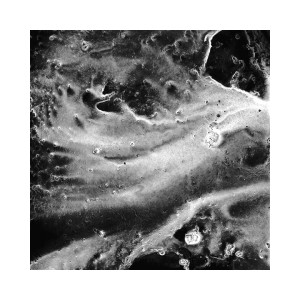The photo abstractions in the on-going series I like to call Obsessive Emulsion Disorder are made without using a camera. I expose black and white sheet film to a bare light bulb to produce a solid black negative in which all possible visual information (in the form of silver halide grains) is present. The black negative is a metaphor of chaos, but within that chaos is the potential for an infinite array of meaningful patterns waiting to reveal itself.
This revelation is accomplished by soaking the black negative in water, which slowly dissolves the colloid. This releases the silver, which can re-arrange itself free of any ego intent. The silver migrates on the film plane, slumping and thickening, or spreading and thinning. Different degrees of viscosity in the colloid influence how the silver  halide moves and how thick or thin it becomes. I can intervene at this point to influence the movement, but seldom do. My only tools for assisting the migration of the silver are a drinking straw to blow on the negative and an eyedropper for filling in abandoned space.
halide moves and how thick or thin it becomes. I can intervene at this point to influence the movement, but seldom do. My only tools for assisting the migration of the silver are a drinking straw to blow on the negative and an eyedropper for filling in abandoned space.
The next step is to reverse the process by drying the negative through evaporation, which hardens the colloid and fixes in place the redistributed silver halide. This often introduces fracturing, granulation and crystalization into the process. Most negatives are finished in two to three weeks. The longest I have spent on a single negative is 179 days.
The photographic enlargements resulting from these negatives are non-documentary images with the precision, detail, and tonal range of traditional documentary photography but with no documentary connection to the world. They do not and cannot represent perceptions or preconceptions by the artist. The images emerge from somewhere other than the artist’s ego, specifically from the chaotic potential of the film emulsion itself, though the darkroom artist is a necessary catalyst in the process.
I began using 4 x 5 negatives but have moved to 8 x 10, which I often scan and print digitally because I find imagery in sections of the negative (2 x 2 or less) too small to print with an enlarger.
My experience creating Obsessive Emulsion Disorder has convinced me there is no way to predict the outcome of this process, so when my ego tries to exert control it fails. Every image contains an element of surprise. When the result holds my attention over a sustained period of time, I feel I have achieved something spiritual—a heightened awareness of aspects of reality previously unseen.
The series Obsessive Emulsion Disorder received an Ohio Arts Council Award for individual excellence in photography.